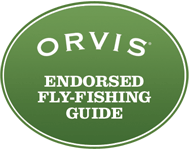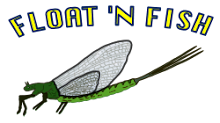 How many times have you opened up your fly box to look for that one fly that is just a bit different and might give you the edge during a hatch? Many times, I have stared into my box at the usual flies that every fly shop carries and almost every angler on the water has in their boxes. On day as I was fishing damsels, I was facing the same dilemma. I needed just one fly that might be a bit different from all the others. The Red Headed Damsel was just the fly. It had the damsel nymph characteristics; the long marabou tail, segmentation and a thicker thorax. What made it different was the bright red glass bead on the head. It made a difference that day, as well as many other days. I often fish this fly on a floating leader, making short twitches, always retrieving towards the shore. Natural damsels migrate towards the shore, looking for anything that might be used as a hatching platform. Often times, they end up on your waders if you are float tubing. Others who make they journey towards shore are intercepted by cruising trout. Those damsels who make it to shore, climb up rocks or other dry land to emerge into the adult tenerals, often tan or olive colored, before turning into the brilliant blue we often see as they fly around. One other popular method to fish these is to hang them under an indicator and slowly retrieve them towards you. A damsel nymph followed by a callibaetis nymph offers the fish a choice of their meal of the day. The Red Headed Damsel is a very easy fly to tie and only takes a few minutes to tie up a few. So grab some materials and get tying and fishing.
How many times have you opened up your fly box to look for that one fly that is just a bit different and might give you the edge during a hatch? Many times, I have stared into my box at the usual flies that every fly shop carries and almost every angler on the water has in their boxes. On day as I was fishing damsels, I was facing the same dilemma. I needed just one fly that might be a bit different from all the others. The Red Headed Damsel was just the fly. It had the damsel nymph characteristics; the long marabou tail, segmentation and a thicker thorax. What made it different was the bright red glass bead on the head. It made a difference that day, as well as many other days. I often fish this fly on a floating leader, making short twitches, always retrieving towards the shore. Natural damsels migrate towards the shore, looking for anything that might be used as a hatching platform. Often times, they end up on your waders if you are float tubing. Others who make they journey towards shore are intercepted by cruising trout. Those damsels who make it to shore, climb up rocks or other dry land to emerge into the adult tenerals, often tan or olive colored, before turning into the brilliant blue we often see as they fly around. One other popular method to fish these is to hang them under an indicator and slowly retrieve them towards you. A damsel nymph followed by a callibaetis nymph offers the fish a choice of their meal of the day. The Red Headed Damsel is a very easy fly to tie and only takes a few minutes to tie up a few. So grab some materials and get tying and fishing.Hook: Dia Riki 270 #10.
Bead: Medium Silver Lined Red Glass Bead.
Thread: UTC 70 Denier, Olive.
Body: Marabou, olive or brown.
Rib: Small Red wire.
Wing: Leftover Marabou from body.
1. Begin by placing a bead on the hook. Tie in a 6” piece of red wire.
2. Wrap wire to opposite of tip of hook point. Using two wraps of thread, tie in marabou. Make sure it is not too thick of a feather. Lift up marabou and wrap thread to behind bead.
3. Lay marabou down and make three wraps of thread over marabou. Your thread should be behind the bead. The marabou should be tied down at the rear of the fly, and now behind the bead.
4. Make a wrap of wire over exposed thread wraps at the rear of fly. Continue making wraps forward to behind bead. When wrapping the wire, your marabou should “cup” over the hook shank, forming the body.
5. Tie off marabou, making sure you leave a bit of space right behind the bead. Don’t crowd this area.
6. Cut marabou close and cover butts. You should have a little space behind the bead for the next step, placing the wing.
7. Lay the marabou wing on the hook shank. I use the remaining piece from the body. Make sure the feather is tied in the same direction as you did to tie in the tail.
8. Make several wrap directly behind the bead to secure the wing. Cut the wing length about 50% of the fly.
9. Grab 2-3 individual marabou fibers to use as a dubbing to cover up the thread and make a finished tie off.



















%20%E2%80%A2%20Instagram%20photos%20and%20videos.jpg)























No comments:
Post a Comment